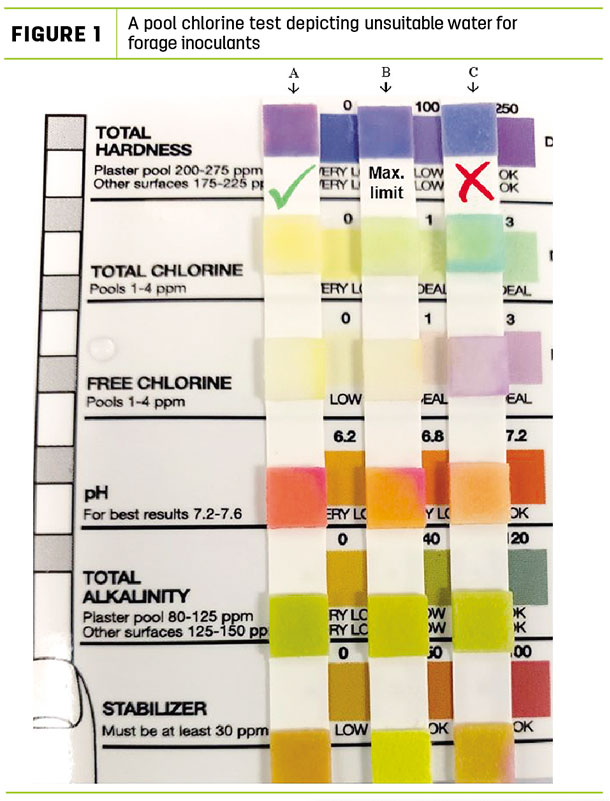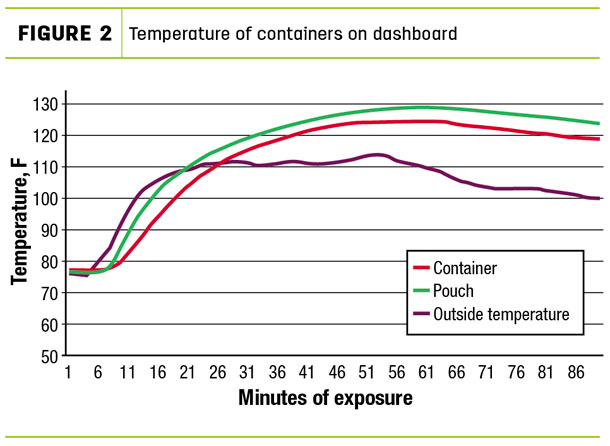In addition, some inoculants also have an inhibitory effect on yeast and mold, resulting in longer aerobic stability or shelf life.
Typical application rates target 100,000 colony-forming units (CFU) per gram of wet forage to ensure the minimum number of bacteria are applied to forages. Therefore, it is important to follow dilution and application instructions very closely and to use calibrated applicators to ensure even application and distribution of the inoculant. While overapplication would likely not hurt fermentation, underapplication would result in an inefficient fermentation pathway. In either case, economic implications are not positive.
The bacteria present in inoculants are typically prepared through a process known as lyophilization or freeze drying. This method of preservation removes water from the bacterial cells and renders them dormant until rehydrated. Consequently, water or moisture is critical for the bacteria in inoculants to awaken and carry out active fermentation of plant sugars for acid production. While there are several factors that contribute to successful utilization of inoculants, water quality and temperature are two of the most critical factors that can dampen the effectiveness of forage inoculants.
Water quality
When using soluble inoculants, water will reactivate the viable bacteria and will also be the carrier or vehicle to distribute the bacteria on the forage mass. Since this water has to support microbial life, it is important to use chlorine-free water. However, some farms may be using potable chlorinated water; in such case, chlorine levels should be less than 1 part per million (ppm). Although most drinking water is below 1 ppm chlorine, water from other sources may have higher levels. Therefore, it may be convenient to test and make sure the chlorine level is below the threshold. A simple pool test kit would be good to assess chlorine level.
Figure 1 depicts three water samples with increasing levels of chlorine. Sample “A” is virtually chlorine-free, and sample “B” depicts the 1 ppm threshold.

Unsuitable water for forage inoculants is represented by sample “C”; to mend this situation, producers may need to find additional sources of water to completely replace or to dilute the chlorine concentration, or choose an inoculant product that contains additives to neutralize chlorine.
Handling prior to inoculant preparation
Since silage inoculants contain viable bacteria, it is critical to ensure integrity of the culture. For this reason, most inoculant products are packed in sealed pouches that prevent air, moisture and light exposure. However, improper storage and handling conditions may still pose a risk for bacterial survival. Figure 2 shows data from two temperature loggers in a container and a pouch similar to those used for packaging forage inoculants.

The samples were then placed on the dashboard of a car; the data loggers registered an increase of 40ºF in a matter of 30 minutes and kept an internal temperature 15 to 20ºF above outside temperature.
There is limited information available regarding storage temperature and bacterial viability of silage inoculants, but literature from food science indicates survival rate of freeze-dried lactic acid bacteria can severely drop when the bacteria are stored at temperatures greater than 98ºF.
The inoculant containers from the car dashboard demonstration gained temperature via solar radiation and convection; the final temperature was registered at 125ºF after 60 minutes of exposure. Due to the variety of inoculant formulations, it is hard to predict what the specific effect of exposure to high temperature is; however, it is reasonable to think heat damage may occur to some degree in forage inoculants during storing and handling.
Temperature during application
Temperature of the water in the applicator tank plays a critical factor in maintaining viable bacteria. Research conducted by the University of Delaware demonstrated that temperature of the water used for inoculant preparation can reduce the number of CFU in forage inoculants. When temperatures above 95ºF were evaluated in the laboratory, researchers concluded that significant reduction in CFU occurred. As expected, temperatures greater than 104ºF resulted in even greater reductions.
To put things in perspective, the reductions in CFU observed for some inoculants would be comparable to theoretical application rates of less than 35,000 CFU and as low as 1,000 CFU when the minimum effective application rate is 100,000 CFU per gram of wet forage. These laboratory findings were corroborated in a field evaluation demonstrating that in a matter of hours, hot tanks have reduced CFU and temperatures greater than 95ºF are not uncommon. This would be commonly observed when the inoculant tanks are close to engines or exhaust pipes on the chopper. Therefore, it is important to maintain prepared inoculants below 85ºF; this can be accomplished by using insulated tanks or by placing frozen water bottles inside the tank. Do not use ice to lower the temperature of the inoculant because the ice will eventually melt and dilute the concentration of CFU in the inoculant.
Take-home messages
- Store forage inoculants in a cool, dry place.
- Check water quality before preparing inoculants, keep chlorine below 1 ppm, or use an inoculant that contains additives to deal with the chlorine.
- Conduct proper maintenance on inoculant applicators in preparation for harvest season, and calibrate appropriately.
- Keep water inside applicator tanks below 85ºF.


-
Hugo A. Ramírez Ramírez
- Animal Science Department
- Iowa State University









